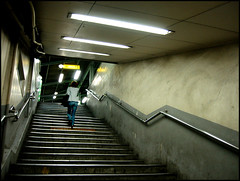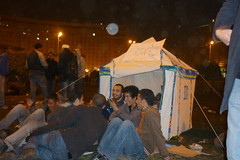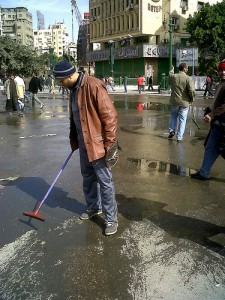Vermessungs des Urbanen 3.0 organisatoren Wie ist die Entwicklung hybrider Räume aus Sicht der Forschung, des Designs und der sozialen Kommunikation einzuordnen, und wie ist die Emergenz neuer Verhaltensmuster in diesen Räumen zu bewerten? Heute steht die physische Natur des städtischen Raums einer Dynamik der Informationsflüsse und neuer Mobilitäten gegenüber. Den Beitrag wird die Eigenschaften dieser Medial Raüme und der sozialen Verhaltensweisen verbunden mit der Verwendung Lokative Medien im städtischen öffentlichen Raum der Stadt mit folgenden Schwerpunkten untersuchen:
Flashmobs
Diese hochgradig choreographierten Performances im öffentlichen Raum zeigen, wie Medien und Technologie neue kollektive Verhaltensmuster ermöglichen. Wie kann der statische Charakter des gebauten Raums auf diese Formen der Mikro-Koordination sozialen Verhaltens reagieren?
Foursquare
Die Verwendung von foursquare.com dokumentiert einer neue Sozialität und Mobilität im städtischen Raum, in dem sich Menschen bewegen und anderen Menschen begegnen: auf Bahnhöfen, Flughäfen, in Cafes, Geschäften und Diskotheken. Lokative Medien ermöglichen neue Formen der Begegnung Fremder im im urbanen Raum. Wie können wir Räume für diese Art von Begegnungen gestalten?
Medien-Fassaden
In städtischen Transit-Räumen gibt es eine wachsende Zahl von Bildschirmen und teils interaktiven digitalen Interfaces, die auf die Anwesenheit von Personen oder auf Eingaben reagieren. Mirjam Struppek hebt in ihren Arbeit die zentrale Rolle der Urban Screens hervor und beginnt, Medien-Fassaden als kreatives Design-Problem in den Blick zu nehmen. Wie können wir im hybriden Raum eine Beziehung zwischen gebauten und medialen Räumen schaffen?
(EN)
It puzzles me that when I look and move around I experience very few obvious changes in the physical nature of urban space. maybe I expect too much. For sure I carry a device with me that augments the space, but the screen is still my interface, it doesn't spill out into the city. The city and the built space itself remains surprisingly neutral (dumb?). The physical world does not respond to my passing or presence. In fact when I try to really grasp how space has been changed it is in these three areas:
flash mobs. These highly choreographed performances in public space show how media and technology can inform new ways of behaving in public space that's moved way beyond rheingolds smartmobs. They come into being through a whole plethora of media platforms, twitter, facebook and sms and demonstrate a temporality that the physical space of the city cannot (will not?) respond to. It can only be a passive observer or stage. How can the static nature of out built environment and space start to respond to these forms of serendipity and micro-coordination of social behaviour? Can hybrid space start to perform, to come together and disperse when its use is over?
foursquare.
The use of foursquare.com represents a new practice of recognising and naming presence in space on technology’s terms. Take a look at foursquare listings at any place and you will find as diverse a set of descriptions for places as you could imagine. It documents the sociality and mobility of places we are present in, where people pass through and encounter others, in train stations, airports, sandwich bars, stores and nightclubs. These are places of shared encounters and experiences, not addresses or locations, and our presence in the physical environment is a presence in this hybrid space. So as locative media re-values the sociality of presence with strangers in urban public space, how can the spaces start to allow for these passing encounters? We simply need a few more places to be ‘slow’ and to stop (without having to pay for a coffee), where we can be present in both digital space and the physical space without causing disruption due to our civil inattention. Is it as simple as more benches, more meeting points? What are the implications of networked social interactions for the design of the built environment of cities, specifically public urban spaces?
facades.
The emerging prevalence of urban screens and media facades cause us to reinterpret both the presence and ‘located-ness’ of technology and in particular the moving images in public space as well as the corresponding effects on patterns of social presence and interaction. Whole façades are superimposed with images and sometimes projections or even screens. Do we need windows in public buildings. anymore? If not, how do we design for spaces that need not look out, but that offer other ways of both enclosing and making interfaces between one space and the next? Our colleague Mirjam Struppek’s work highlights the key issue of urban screens and starts to reclaim screens as a creative design problem. On a broader level, how do we connect our physical spaces with our digital spaces? How do we create a less disjointed hybridity, drawing together the physical requirements of the built space to connect outside and inside, and the media spaces which demand a different kind of accessibility; one which is only concerned with non-visual, unbroken links to the network?
 photo-hyperspace328
photo-hyperspace328
 (Photo by Monasosh on Flickr (CC-BY 2.0).
(Photo by Monasosh on Flickr (CC-BY 2.0).

